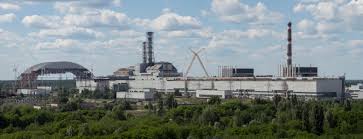Chernobyl.gif

During the Russian occupation of the shuttered Chernobyl nuclear power plant in Ukraine, someone stole radioactive materials from a radiation monitoring laboratory near the plant. A nuclear expert said that there was a low risk that this stolen material could be used to construct a dirty bomb.
The looters took pieces of radioactive waste which could theoretically be used to construct a dirty bomb. This type of bomb combines radioactive materials with a conventional explosive. This was reported by Anatolii Nosovskyi who is the director of the Institute for Safety Problems of Nuclear Power Plants (ISPNPP) in Kyiv. They also took radioactive isotopes. These were radioactive chemical elements with different numbers of neutrons in their nuclei. They are usually used to calibrate monitoring instruments.
On March 25, the journal Science reported that the radioactive materials had been taken. The journal New Scientist later confirmed these reports with an ISPNPP scientist. The source said that the earlier report in the journal Science was “accurate based on the information available.”
The stolen material cannot be used to make nuclear weapons because it does not contain any plutonium or uranium. Bruno Merk is a research chair in computational modeling for nuclear engineering at the University of Liverpool. He said, “There are so many radioactive sources around the world. If someone wants to get their hands on this there's an easier way. These radioactive sources you can steal in every hospital. It would always have been possible for someone to sneak in and steal something. I don't see that the risk is any higher than before the Russians invaded.” Although its not useful for making nuclear weapons, some of the stolen material could be of very limited use in the construction of a dirty bomb, according to Merk.
Edwin Lyman is a physicist and the Director of Nuclear Power Safety with the Union of Concerned Scientists. He said that “Calibration sources typically have very small quantities of radioactive materials.”
If the stolen waste materials were very radioactive, they would need to be stored and transported in heavy shielding to prevent the handlers from serious radiation exposure. Lyman went on to say, “I suspect the stolen samples are also small quantities. I'm skeptical that there would be any strategic purpose for Russia to use these materials in a dirty bomb.”
Lyman said that a dirty bomb could spread radioactive material over a localized area, but it would not cause many immediate sever health effects. He did note that the extent and severity of the potential damage would depend on the size and other characteristics of the materials in question.
Dirty bombs are also known as “radiological dispersal devices” (RDDs) do not release enough radiation to kill people or cause severe illness according to the U.S. Nuclear Regulatory Commission (NRC). Those closest to the bomb when it is detonated would be the most likely to be injured by the conventional explosives in the bomb. The radioactive materials in the bomb could be dispersed within a few blocks or miles from the site of the explosion.” The NRC also said, "As radioactive material spreads, it becomes less concentrated and less harmful. “Immediate health effects from exposure to the low radiation levels expected from an RDD would likely be minimal.
Lyman said, “It's unlikely that such a bomb could cause death, destruction and terror anywhere near the scale of Russia's bombardment of civilian areas with conventional weapons. Although the presence of radioactive contamination could add another element of fear to an already frightful situation.”